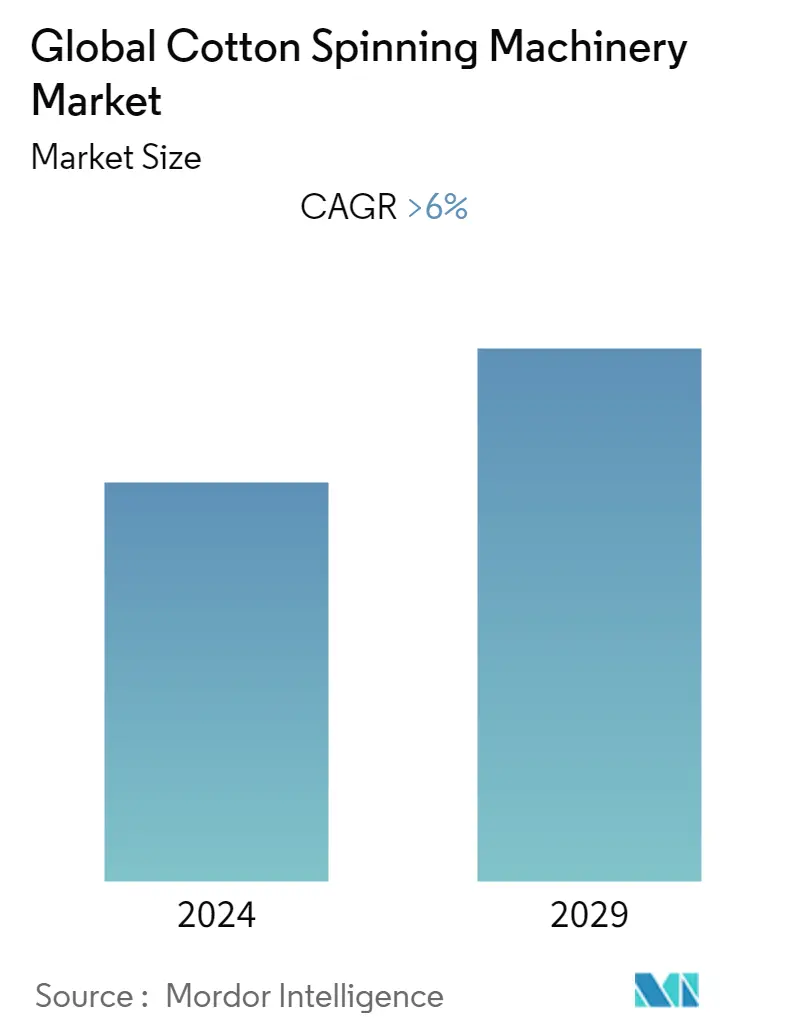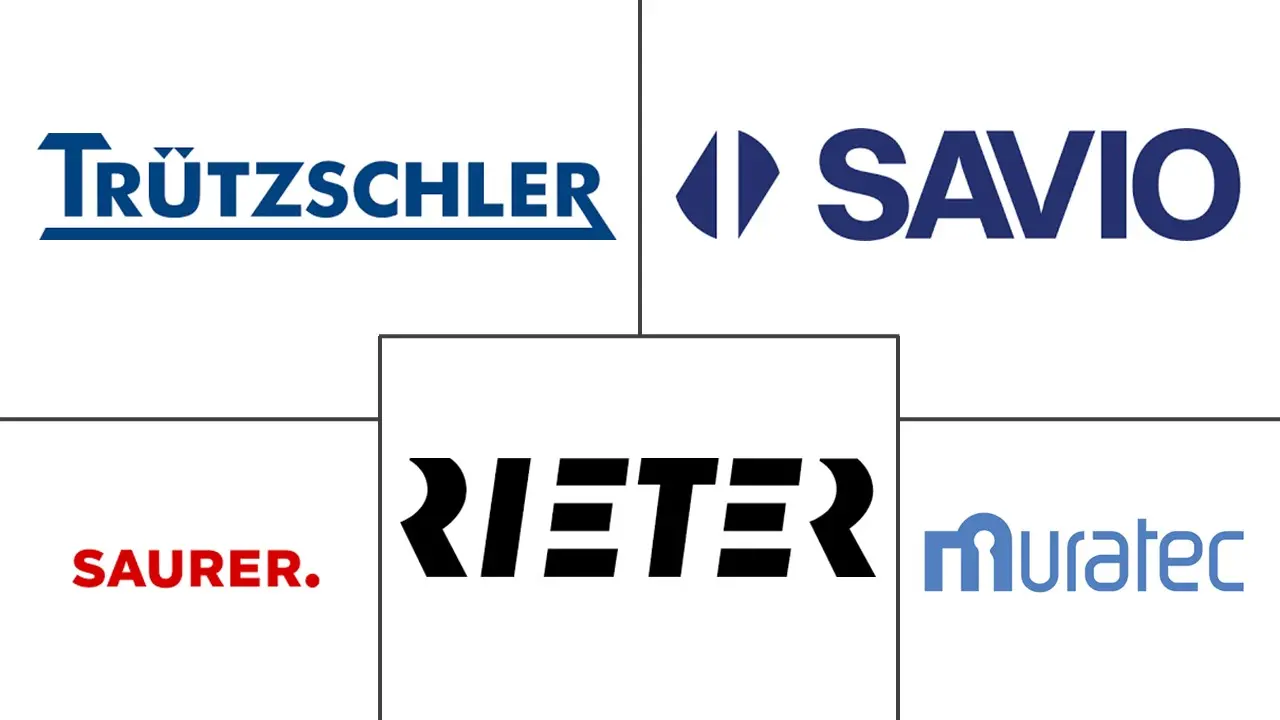
| Study Period | 2020 - 2029 |
| Base Year For Estimation | 2023 |
| Forecast Data Period | 2024 - 2029 |
| CAGR | 6.00 % |
| Fastest Growing Market | Asia-Pacific |
| Largest Market | Asia-Pacific |
| Market Concentration | Low |
Major Players
*Disclaimer: Major Players sorted in no particular order |
Cotton Spinning Machinery Market Analysis
The size of the Cotton Spinning Machinery Market is valued at about USD 1.2 billion in the current year and is anticipated to register a CAGR of over 6% during the forecast period.
- There is a rise in demand for natural fabrics such as cotton which is one of the main factors driving the market. Furthermore, the increasing domestic demand for cotton textiles in Asia-Pacific is driving the market due to the high demand for machinery by the local mills.
- The future looks bright for spinning linen mills, thanks to the rapid growth in demand for fabrics for ready-made clothing. Spinners can currently produce a large portion of the raw material required for the knitwear and woven segments. However, spinning cotton mills are looking to expand their production capacity to meet rising demand. Bangladesh is one of the leading exporters of apparel raw materials. To meet these rising export demands, the Bangladeshi government has also taken steps to assist spinning mills in producing more raw materials for export to other countries. This initiative has greatly aided Bangladesh, as countries such as South Korea, Turkey, and Egypt collaborate with the Bangladesh Textile Mills Association to purchase raw materials from the country.
- The domestic market is expanding as India and other countries in Asia-Pacific have surpassed countries such as the United States and Japan in terms of consumption. The local market is expanding as consumers shift away from need-based purchasing and toward aspiration-based purchasing. Another factor enabling domestic market growth is the increasing participation of women in the labour force, as well as India's steady rise to become one of the world's largest e-commerce markets. Shorter lead times and higher-quality raw materials produced by local spinners are attracting an increasing number of companies to purchase fabrics from them. When sourcing from the local market, it takes less time.
- Over time, technology has played an important role in increasing the success of spinning cotton mills. More than ever before, industries are striving for perfection. Quality is critical to please and satisfy customers. Mills are harnessing the power of technology to achieve high levels of precision. Changes brought about by technology also enable cost-effectiveness. Labor, maintenance, and production costs are reduced by the new technology. Better energy sources are used by machinery. Knowing the benefits of solar energy, spinning linen and cotton mills are gradually transitioning to it. Clothing trends are changing at a rapid pace nowadays. Mills rely heavily on technology to keep up with these changes. Spinning cotton mills use artificial intelligence to produce raw materials that are precisely tailored to the preferences of customers all over the world.
- New investments are creating new opportunities for linen and cotton mills. Spinners are increasing their investments, and new mills are opening to help meet the increasing number of orders. This increased manufacturing capacity will result in increased investment in the textile industry. The spinning sector will receive a significant portion of these investments, while the dyeing and finishing processes will receive the remainder. Jinnat Spinning Mills Limited, Karim Tex Limited, and Mahin Group are among the new companies planning to invest in spinners. These organizations are collectively investing billions of dollars to boost yarn production in mills.
Cotton Spinning Machinery Industry Segmentation
Spinning is the process of winding drawn-out strands of fiber together to form a yarn. It is a significant component of the textile industry. Spinning is used in the production of various textile fibers. Ring, Rotor, and Air-jet spinners are the three types of spinners used in the textile industry. A complete background analysis of the Global Cotton Spinning Machinery Market, including the assessment of the economy and contribution of sectors in the economy, market overview, market size estimation for key segments, and emerging trends in the market segments, market dynamics, and geographical trends, and COVID-19 impact, is covered in the report.
The Global Cotton Spinning Machinery Market is segmented By Type (Ring Spinning, Compact Spinning, Rotor Spinning, and Air Jet Spinning), By Application (Clothing, Textile, and Other Industries), and By Geography (North America, Asia-Pacific, Europe, Middle East & Africa and South America). The report offers the market size and forecasts value (USD billion) for all the above segments.
| Ring Spinning |
| Compact Spinning |
| Rotor Spinning |
| Air Jet Spinning |
| Clothing |
| Textile |
| Other Industries |
| North America | United States |
| Canada | |
| Mexico | |
| Europe | Germany |
| France | |
| United Kingdom | |
| Italy | |
| Spain | |
| Russia | |
| Rest of Europe | |
| Asia-Pacific | China |
| Japan | |
| India | |
| Bangladesh | |
| Turkey | |
| South Korea | |
| Australia | |
| Indonesia | |
| Rest of Asia-Pacific | |
| Middle East & Africa | Egypt |
| South Africa | |
| Saudi Arabia | |
| Rest of Middle East & Africa | |
| South America | Brazil |
| Argentina | |
| Rest of South America |
Global Cotton Spinning Machinery Market Size Summary
The global cotton spinning machinery market is experiencing significant growth, driven by the increasing demand for natural fabrics like cotton. This demand is particularly strong in the Asia-Pacific region, where domestic consumption of cotton textiles is on the rise. The expansion of spinning mills in countries such as Bangladesh, supported by government initiatives, is helping to meet the growing export demands for apparel raw materials. The market is further bolstered by technological advancements that enhance production efficiency and quality, allowing mills to produce high-quality raw materials tailored to global consumer preferences. The shift towards aspiration-based purchasing and the growing participation of women in the workforce are also contributing to the expanding domestic market in countries like India.
The market landscape is characterized by a mix of local, regional, and global players, with major companies such as Rieter AG and Saurer Schlafhorst GmbH & CO. KG leading the charge. Despite challenges like supply chain issues and rising fuel prices, the market continues to attract new investments, with companies expanding their production capacities to meet increasing orders. The global textile industry, closely linked to cotton production, is poised for growth, with countries like China, India, and the United States playing pivotal roles as top producers and exporters. Innovations in spinning technology and the strategic use of renewable energy sources are expected to drive further advancements in the industry, ensuring its continued expansion during the forecast period.
Global Cotton Spinning Machinery Market Size - Table of Contents
1. MARKET SEGMENTATION
-
1.1 By Type
- 1.1.1 Ring Spinning
- 1.1.2 Compact Spinning
- 1.1.3 Rotor Spinning
- 1.1.4 Air Jet Spinning
-
1.2 By Application
- 1.2.1 Clothing
- 1.2.2 Textile
- 1.2.3 Other Industries
-
1.3 By Geography
- 1.3.1 North America
- 1.3.1.1 United States
- 1.3.1.2 Canada
- 1.3.1.3 Mexico
- 1.3.2 Europe
- 1.3.2.1 Germany
- 1.3.2.2 France
- 1.3.2.3 United Kingdom
- 1.3.2.4 Italy
- 1.3.2.5 Spain
- 1.3.2.6 Russia
- 1.3.2.7 Rest of Europe
- 1.3.3 Asia-Pacific
- 1.3.3.1 China
- 1.3.3.2 Japan
- 1.3.3.3 India
- 1.3.3.4 Bangladesh
- 1.3.3.5 Turkey
- 1.3.3.6 South Korea
- 1.3.3.7 Australia
- 1.3.3.8 Indonesia
- 1.3.3.9 Rest of Asia-Pacific
- 1.3.4 Middle East & Africa
- 1.3.4.1 Egypt
- 1.3.4.2 South Africa
- 1.3.4.3 Saudi Arabia
- 1.3.4.4 Rest of Middle East & Africa
- 1.3.5 South America
- 1.3.5.1 Brazil
- 1.3.5.2 Argentina
- 1.3.5.3 Rest of South America
Cotton Spinning Machinery Market Research FAQs
What is the current Global Cotton Spinning Machinery Market size?
The Global Cotton Spinning Machinery Market is projected to register a CAGR of greater than 6% during the forecast period (2025-2030)
Who are the key players in Global Cotton Spinning Machinery Market?
Rieter AG, Saurer Schlafhorst GmbH & CO. KG, Trutzschler group, Muratec Murata Machinery, Ltd. and Savio Macchine Tessili S.p.A. are the major companies operating in the Global Cotton Spinning Machinery Market.


